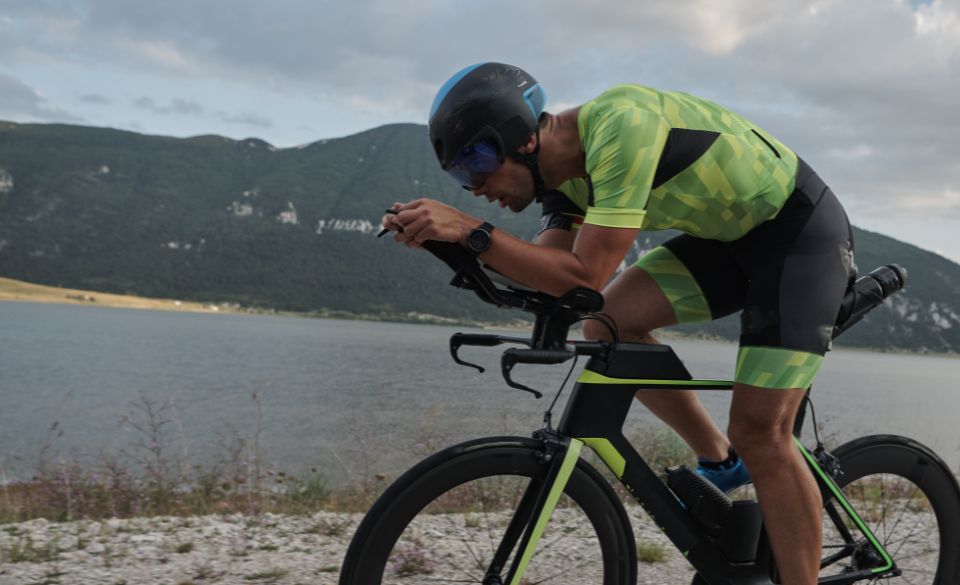
Splits to Break 9 Hours in the Ironman: Strategy for Elite Performance
Page Contents
Breaking the 9-hour barrier in an Ironman triathlon is a remarkable achievement that requires meticulous planning, disciplined training, and strategic execution. To accomplish this extraordinary feat, athletes must maintain a consistent and efficient pace across all three disciplines: swimming, cycling, and running. In this article, we’ll explore the splits necessary to break 9 hours in an Ironman and the key strategies employed by elite athletes to achieve this elite level of performance.
Understanding the Sub 9-Hour Ironman Goal
Completing an Ironman triathlon involves swimming 2.4 miles (3.86 km), cycling 112 miles (180.25 km), and running a full marathon of 26.2 miles (42.2 km). To break the 9-hour mark, athletes must not only excel in each individual discipline but also seamlessly transition between them. Let’s break down the splits required to achieve this extraordinary feat.
Swim Split:
A strong swim split sets the foundation for a successful race. Elite athletes typically aim to complete the 2.4-mile swim in under 50 minutes to conserve energy for the demanding bike and run portions. Maintaining a consistent pace and utilizing efficient stroke mechanics are crucial to maximizing swim performance and minimizing fatigue.
Bike Split:
The bike leg offers the greatest opportunity for time gain in an Ironman. To break 9 hours, athletes need to complete the 112-mile bike course in approximately 4 hours and 45 minutes. This equates to maintaining an average speed of around 23.5 miles per hour (37.8 km/h). Strategic pacing, effective fueling and hydration, and maintaining a streamlined and aerodynamic position on the bike are essential for achieving this split.
Run Split:
After swimming and cycling, athletes must complete the final marathon run within a specific time frame to break the 9-hour mark. To achieve this, they aim to maintain a consistent and controlled pace, avoiding early fatigue. Running at a pace of approximately 6:30-6:45 minutes per mile (4:02-4:12 minutes per kilometer) is necessary to complete the 26.2 miles in under 3 hours and 30 minutes.
Key Strategies for Breaking 9 Hours in the Ironman
Achieving sub 9-hour Ironman splits requires careful planning and execution. Here are some key strategies employed by elite athletes to maximize their performance:
Pacing and Race Strategy:
Maintaining a steady and sustainable pace throughout the race is crucial. Athletes strategically allocate their energy and effort, avoiding early burnout and saving enough for a strong finish. Balancing intensity with conservation of energy is key to achieving sub 9-hour splits.
Transitions:
Efficient transitions play a vital role in breaking the 9-hour mark. Athletes aim to minimize the time spent in transition areas by practicing quick and seamless transitions during training. Organizing gear, prepping nutrition, and mastering the art of swift changes contribute to valuable time savings.
Nutrition and Hydration:
Fueling the body adequately during an Ironman is vital to sustain energy levels and performance. Achieving sub 9-hour Ironman splits requires careful attention to nutrition and hydration strategies. Research published in the International Journal of Sport Nutrition and Exercise Metabolism suggests that optimal nutrition can significantly impact performance and recovery in endurance events like the Ironman.
To maintain energy levels during the race, athletes focus on consuming a combination of carbohydrates, proteins, and fats. Carbohydrate intake before, during, and after the race helps replenish glycogen stores and provides the necessary fuel for endurance performance. Proper hydration is equally important to prevent dehydration and maintain electrolyte balance.
Athletes often work with sports nutritionists to develop personalized nutrition plans that meet their specific needs and optimize their performance.
Mental Resilience:
Beyond the physical demands, achieving sub 9-hour Ironman splits requires unwavering mental strength. Endurance events push athletes to their limits, and overcoming mental barriers is crucial for success.
Mental strategies such as goal-setting, positive self-talk, visualization, and mindfulness can help athletes stay focused, maintain motivation, and push through moments of fatigue and doubt. Mental toughness training, including simulated race scenarios and mental resilience exercises, can enhance an athlete’s ability to handle the challenges of an Ironman and maintain a strong mindset throughout the race.
The Training Approach: Balancing Volume and Intensity
Achieving sub 9-hour Ironman splits requires a meticulous training approach that balances volume and intensity. A study published in the Journal of Strength and Conditioning Research explored the training characteristics of elite Ironman triathletes. The findings revealed that successful athletes incorporated a mix of high-volume, low-intensity sessions, along with targeted high-intensity workouts to improve speed and power.
Endurance is developed through long training sessions, including extended rides, runs, and brick workouts (combination of bike and run). These sessions focus on building cardiovascular fitness, muscular endurance, and mental resilience.
To improve speed and intensity, interval training plays a crucial role. Intervals involve alternating periods of high-intensity effort with recovery periods. This type of training helps improve lactate threshold, anaerobic capacity, and overall race pace.
Famous Athletes Who Have Achieved Sub 9-Hour Ironman Splits
Several remarkable athletes have etched their names in Ironman history by achieving sub 9-hour splits. These individuals have displayed extraordinary levels of athleticism, perseverance, and determination. Notable names in the sub 9-hour Ironman club include Jan Frodeno, Tim Don, and Lucy Charles-Barclay.
Jan Frodeno, a German triathlete and Olympic gold medalist, set a new world record in 2019 with a stunning time of 7 hours, 51 minutes, and 13 seconds at the Ironman European Championship in Frankfurt. Tim Don, a British triathlete, made a remarkable comeback from a severe injury to achieve a sub 9-hour performance with a time of 7 hours, 40 minutes, and 23 seconds at the Ironman South American Championship in 2017. Lucy Charles-Barclay, a British triathlete known for her swimming prowess, achieved a sub 9-hour time of 8 hours, 31 minutes, and 09 seconds at the 2019 Challenge Roth race.
While the above athletes have gone on to be some of the best long distance triathletes in the world, thousands of amatuer athletes have now gone under the magical 9 hour mark. This shows, for a lot of people a sub 9 hour Ironman is not as difficult as it once was.
Conclusion: Chasing the Sub 9-Hour Dream
Breaking 9 hours in an Ironman is a monumental achievement that requires a blend of physical prowess, strategic planning, and mental toughness. Elite athletes who achieve this extraordinary feat demonstrate the highest levels of dedication, training, and execution. Aspiring triathletes can draw inspiration from their performances, understanding that with the right approach, disciplined training, and unwavering determination, the sub 9-hour Ironman goal is within reach.



